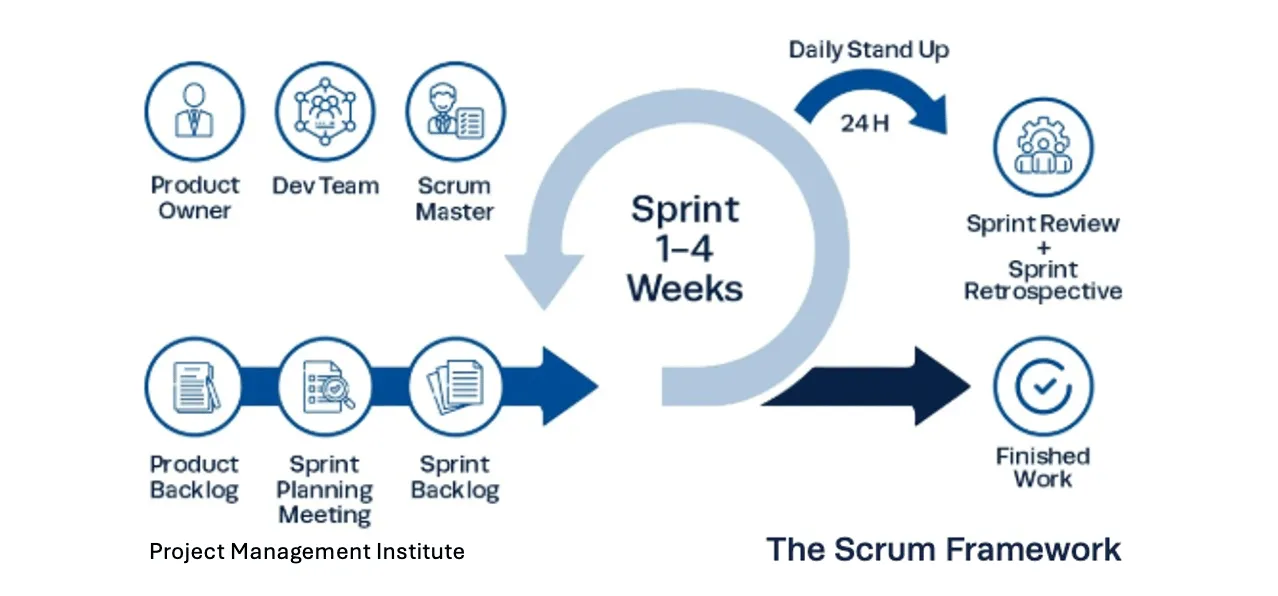Create Context not Chaos

Are some team-members ‘quiet-cracking’? Transforming your organization for the dynamism of modern work is vital so employees adapt—not crack—from the unpredictability, pace and pivots to scale your AI-powered business effectively.
“Uncertainty is going to be the norm. It's going to be there for some time," Janet Truncale, EY's CEO and global chair.
Change without Context = Chaos
People don’t feel at ease. Change is constant. Uncertainty is unavoidable. ‘VUCA’ on AI steroids. Without context, fast-paced evolution generates feelings of instability. Overwhelm can lead to burnout—where employees feel hopeless, trying to meet goals amidst continuing, seemingly uncontrollable chaos.
The data is stark about job insecurity, AI, geopolitical and economic concerns:
- 66% of US employees are experiencing burnout [Moodle, 25].
- 85% had symptoms of burnout or exhaustion from work-related stress.
- 91% of 18-34 year olds reported symptoms like fatigue [The Interview Guys, State of Workplace Burnout '25].
- 85% of UK workers have experienced symptoms of burnout.
- 47% have needed time off work for their mental health [The Times '25].
“Business leaders are facing change and tough decisions on all fronts, from quickfire tariff policies and stock market swings, to how to implement AI and handle generational shifts in the job market” [BI '25]
Digital Transformation 1.0 = Failure
Everyone MUST (re)engage for your business to grow sustainably while embedded technologies shift our ecosystems' foundations.
To facilitate digital transformation in the 2010s, consulting groups offered digitally-focused frameworks, such as Deloitte’s Digital Transformation Framework and Forrester’s Digital Maturity Model 4.0.
But >70% of ‘Digital Transformation 1.0’ efforts failed from insufficient human-centric integration and systemic support [McKinsey] and mindsets unshifted to "adapt to changing contexts..and “fail-fast-learn” behavioral change [BCG].
Systems Shift

Taking rugby football's 'scrum' play in a tech team environment, Agile emerged as a collection of frameworks (incl. the Scrum Framework) for software development, focused on flexibility and collaborative iterative development.
Select tech-based firms adapted Agile to help frame and facilitate digital shifts:
Spotify developed an Agile framework based on continuous collaboration, feedback, and experimentation to react quickly to market and customer needs.
ING reorganized into 350 nine-person “squads” in 13 so-called "tribes", improving time to market, boosting engagement, and increasing productivity.
Agile for Sports Management has also been a specific use case to enable more flexibility in a non-tech sector.
Familiar, Flexible, Dynamic
AI has generated new urgency for Digital Transformation 2.0. For non-tech workers and businesses, digital frameworks can be too alien or abstract. Translating flexible frameworks (back) into familiar context is necessary for people to adopt—not resist and struggle with—our new more complex, dynamic system, e.g.:

- Sports Team Framework – recognizing how dynamic sports settings foster fast-moving team member interactions and collaboration with playbooks, real-time adjustments, specialized empowered pods, and frontline decision-making [e.g. Cisco, and other interpretations].
- Seasonal Cycle Framework – using nature’s seasonal shifts and agriculture style [e.g. Farmer’s Almanac] season-based and weather-adjusting norms to elevate company-specific sustainable seed-grow-harvest-reset rhythms, already reflected in business seasons and cycles.
- Hollywood Production Framework – copying century-old rigorously-defined creative project processes to assign, track, and measure growing numbers of cross-functional, collaborative, unique projects [e.g. blur production-to-advertising agency lines, other interpretations].
Expecting or driving for constant high-intensity performance during ongoing uncertainties is anxiety-inducing and unsustainable for your teams, unsustainable, and increases business risk. Use well-known dynamic frameworks that incorporate healthy, beneficial cadences to reduce pressure: sports teams in/off-season rhythms, nature’s four-phased cadence, and production ebbs and flows.
Compare traditional and flexible frameworks to see which suits your company:
Digital DNA

Human-centric workforce innovation in the age of AI
workforce and scale your business, navigating the fast-paced
unpredictable marketplace.
Generational EQ

Imagine the market shifts overnight. Could your teams respond swiftly and sustainably? Or would stress, costly confusion or delay win? Which framework could your teams embrace most easily to flex effectively?
Distributed Works

Corinne Murray and I–with deep experience in workplace strategy and workforce innovation–bring you SYSTEMSHIFT.WORK responding to current business challenges and pressure and workplace stress. We provide innovative but familiar workforce and workplace strategies that empower your team and company to drive the substantial system shift needed to adapt to modern work.
We elevate familiar non-tech frameworks which have dynamic characteristics to reroot and integrate adaptive principles that can be applied with broader relevance and clarity. Used in context, these reduce worker stress and facilitate participation and adoption and accelerated, enabling sustainable growth.
We recommend a Chief Shift Officer—or relevant CXO equivalent—necessary to lead and facilitate the ongoing significant, human-centric digitalization drive. Your company’s new flexible framework and organizational system must be led by a strategic senior executive to design, integrate, and oversee its implementation and evolution, unifying HR, Real Estate & Facilities, and IT.
BUILT ON PROVEN STRATEGIES AND PRACTICES
Practical strategies and practices for senior leaders to align hybrid, multigenerational teams and drive adoption—without burnout.
High-growth leaders know success depends on more than strategy: it’s about execution at speed, with teams aligned and engaged.
Empowering High-Performing Teams is my new self-paced course, built on fined strategies and practices used by 630,000+ leaders worldwide (4.7/5 average rating, delivered in 15+ countries) to help you:
· Lead hybrid, multigenerational teams with clarity
· Drive technology adoption—including AI—with less resistance
· Retain top talent and keep execution velocity high
· Convert workplace complexity into measurable outcomes
The course packs:
• 10 concise video modules designed for busy leaders
• Practical tools, quizzes, and exercises with downloadable worksheets
• Weekly LIVE Office Hours to troubleshoot real-world challenges
• Certificate of completion to showcase achievement
My courses are well-received worldwide:
“An absolutely phenomenal course. Great content and delivery.” — Russell D., Crew Support Specialist, Riyadh Air
“The course helped me listen with intent and validate perspectives—stronger connections, better results.” — Robert T., Founder & CEO
Launch promo pricing (limited time): US $149 • UK £129 inc-VAT • EU €149 inc-VAT. (A fraction of turnover cost—skills you’ll apply immediately.)
Scaling Skills-first

Find and Fit a Flexible Framework
Which framework suits your workforce and business? What working rhythms resonate broadly? Use the following steps to identify which of the different frameworks is best fitted to enable your company to transform:
- Begin with a Stress Diagnostic — Where are decisions stuck? Where is burnout highest? Identify points where rigid processes create friction—such as unclear priorities, constant firefighting, or uneven workloads.
- Pick a Familiar Framework — Coordinate with your teams to choose a flexible framework that they can relate to (e.g. Sports, Seasonal, adapted Agile) and run a pilot in one business unit/group (go to SystemShift.work)
- Co-Design Rituals & Roles, Not Rules — Map how the framework will work day-to-day, agree on key roles, and possible rotating leads to create rhythm with clear boundaries, and define success metrics.
- Set Cadence & Checkpoints — Establish frequent check-ins, seasonal “huddles” or “wraps” for alignment and learning, allowing for in/off-season energy level differences.
- Measure & Iterate Intentionally — Track well-being indicators (burnout risk, ergonomic stress, sentiment) and performance signals (speed of adaptation, idea execution)—balancing autonomy with guardrails.
Human-centric Leadership Audit

News & Muse

📘 Servant Leadership, Robert Greenleaf - the nature of legitimate power.
🗞️ A Model for Adaptive Regulation - legal frameworks respond to tech.
📹 How professional athletes practice good teamwork, Emile Studham.
🎶 Changing Seasons, Gareth - Adapting to life's natural cadence.
By translating a framework that incorporates dynamism within a familiar context, you shift employees' ability to operate and work flexibly. They can respond more easily to ongoing marketplace changes and customers' needs. You swap confusion and chaos for clarity.
Sharing customized insights, I can assist your growth with updated leadership skills so your business can scale effectively. Click here to book a 30-minute session.
Next week, I'll address the third essential shift.
Until next time!
Sophie
P.S. Is your team fulfilling their potential? Start my new course Empowering High-Performing Teams now to build new capabilities as September begins.
Scalable strategies. Tactical talk. Workforce transformation.
Human-centric workforce innovation in the age of AI
workforce and scale your business, navigating the fast-paced
unpredictable marketplace.
